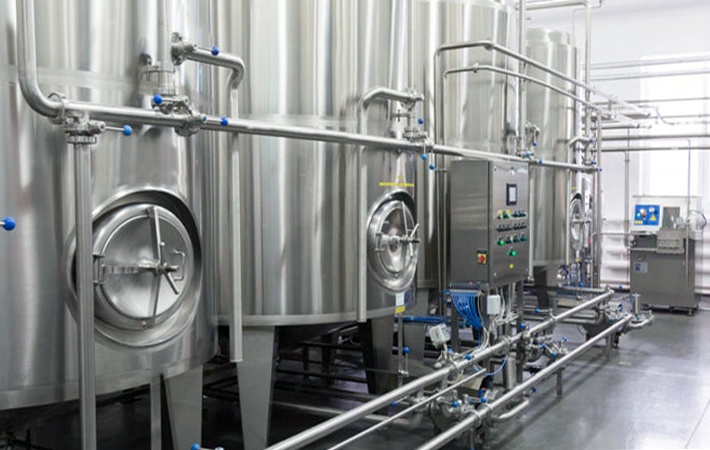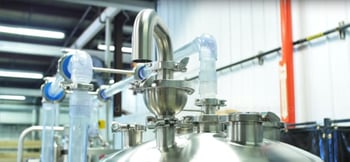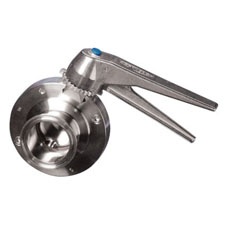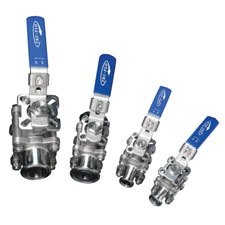
 If you’re working with a sanitary fluid process application, you need to pay close attention to the valves in your system. Sometimes a valve that you might think is sanitary, isn’t actually the best choice for cleanliness. This topic can get controversial, but we’re going to discuss which valves are good for sanitary applications, and which valves you should avoid.
If you’re working with a sanitary fluid process application, you need to pay close attention to the valves in your system. Sometimes a valve that you might think is sanitary, isn’t actually the best choice for cleanliness. This topic can get controversial, but we’re going to discuss which valves are good for sanitary applications, and which valves you should avoid.
In general, valves with a high internal polish and no internal cavities are the best for sanitary applications. Most sanitary applications involve thick viscous fluids and/or solids, so it is important to create the smoothest flow path. The valve connection should mate up to piping uniformly with weld or clamp/gasket style connections.
 A butterfly valve is one of the most common valves for sanitary applications because it lacks internal cavities or voids. Internal cavities promote product buildup, which will result in bacterial contamination. The absence of these cavities in a butterfly valve allows you to avoid contamination, making it a good sanitary valve option.
A butterfly valve is one of the most common valves for sanitary applications because it lacks internal cavities or voids. Internal cavities promote product buildup, which will result in bacterial contamination. The absence of these cavities in a butterfly valve allows you to avoid contamination, making it a good sanitary valve option.
Single-seated and mix-proof (double-seated) valves are another good sanitary option. These are linear plug-style valves with canister-style cylindrical actuators. Unlike butterfly valves, the plug design eliminates the disc in the flow path. Again, this helps to avoid contamination. The actuators are easier to clean than an industrial style rack-and-pinion actuator. Think of a food plant doing a wash down of equipment.
Mix-proof valves can also run 2 products (or one product and a CIP cleaning solution) simultaneously, functioning as 2 separate valves. These dual-acting seats avoid spillage and cross contamination.
For pharmaceutical sanitary applications, a diaphragm valve is a great option. Since there is nothing in the flow path, it can be easily sanitized and sterilized. It is also more cost-effective than a single-seated valve. For extreme applications, a Zero Dead Leg (ZDL) diaphragm valve can be completely drained to avoid trapped media.
The industry usually dictates what the requirements and standards are for the valve; 3A, PMO, FDA, USDA. For more information on these standards, please contact your valve manufacturer.
When selecting your sanitary valve, you should look for the following characteristics:
 Ball valves are not typically considered a sanitary valve, or at least a true 3A sanitary valve. Ball valves that are labeled 3A are polished to 3A standards and use 3A approved materials. They can also have sanitary clamp or weld style connections like butterfly valves. However, the general design of a ball valve with its internal cavities is not ideal for sanitary applications.
Ball valves are not typically considered a sanitary valve, or at least a true 3A sanitary valve. Ball valves that are labeled 3A are polished to 3A standards and use 3A approved materials. They can also have sanitary clamp or weld style connections like butterfly valves. However, the general design of a ball valve with its internal cavities is not ideal for sanitary applications.
If you must use a ball valve for your sanitary application, you should at least opt for a 3-piece valve that can be completely removed and disassembled for COP cleaning. Your process will only be as clean as you make it. Failure to remove, disassemble and clean your ball valves on a regular schedule will allow bacteria to form. A conventional “sanitary” ball valve should never be used for CIP cleaning.
Gate and globe valves are also poor choices for sanitary applications. They do not have a smooth flow path and are not conductive to cleaning or contamination prevention. Any valve that has potential for bacteria contamination should be avoided in any sanitary food or pharmaceutical process.
If you have questions, or would like to add a sanitary valve to your process, please contact us. One of our experienced engineers will help select and/or install the perfect valve(s).
These Stories on Valves
Headquarters and Service Center
Located outside Green Bay, WI
707 Ford Street
Kimberly, WI 54136
920-733-4425
OptiFlow Design and Build Center
1002 Truman Street
Kimberly, WI 54136
920-733-4425
Burnsville Service Center
12265 Nicollet Avenue
Burnsville, MN 55337
952-444-1949
Grand Rapids Service Center
26489 Industrial Blvd
Cohasset, MN 55721
952-444-1949
© Copyright 2024. Crane Engineering. All Rights Reserved. Privacy Policy.